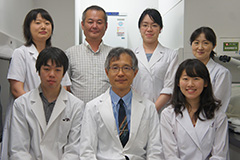-
Affiliation
-
School of Medicine, Collaborative Research Resources (Laboratory of Cell and Tissue Biology) (Shinanomachi)
-
Position
-
Professor

KEIO RESEARCHERS INFORMATION SYSTEM |
Details of a Researcher
このページはJavascriptを使用しています。すべての機能を使用するためにはJavascript を有効にする必要があります。
Matsuo, Koichi
|
|
|
Lab of Cell and Tissue Biology (2017)

研究室は、破骨細胞、さらに破骨細胞と骨芽細胞の相互作用(カップリング)に関する一連の骨代謝学の研究で成果を挙げた。近年では、骨の三次元的な形態形成に研究の焦点を移し、内軟骨性骨化や生後の骨形態変化のメカニズムを、マウスやニホンザルなどの実験動物を用いて解析している。「多様なサイズとかたち」を生み出し、それを成長させ、維持し修復する細胞レベルのメカニズムは本質的なものであるにもかかわらず、不明な点が多い。新たな研究領域を開拓しようと、長管骨や椎骨に加え、耳小骨や頭蓋底骨などを対象として解析力を高めている。さらに放射光施設SPring-8(兵庫)におけるX線位相顕微鏡によるCT撮影(東北大学との共同研究)では、 細胞レベルの解像度で、内軟骨性骨化を担う骨形成性毛細血管の構造を明らかにした。研究室を挙げて形態形成原理の追究に精力を注いでいる。
Chief, National Institute for Longevity Sciences, Chief
Associate Professor, School of Medicine, Keio University, Department of Microbiology and Immunology, Associate professor
Keio University School of Medicine, Department of Microbiology and Immunology, Associate Professor
Keio University School of Medicine, Laboratory of Cell and Tissue Biology, Professor
総合医科学研究センター長
Bone Metabolism
Osteoimmunology
Life Science / Cell biology (Cell Biology)
Life Science / Anatomy (General Anatomy(includes Histology/Embryology))
osteoclast
auditory ossicles
bone modeling
bone remodeling
osteocyte
内軟骨性骨化における骨形成性血管の解析,
骨の形態形成とバイオミネラリゼーション・恒常性維持のメカニズムを、細胞間相互作用によって解明することを目指している。,
Trans-pairing between osteoclasts and osteoblasts shapes the cranial base during development
Edamoto M., Kuroda Y., Yoda M., Kawaai K., Matsuo K.
Scientific Reports (Scientific Reports) 9 ( 1 ) 2019.12
Yang M., Arai A., Udagawa N., Zhao L., Nishida D., Murakami K., Hiraga T., Takao-Kawabata R., Matsuo K., Komori T., Kobayashi Y., Takahashi N., Isogai Y., Ishizuya T., Yamaguchi A., Mizoguchi T.
Journal of Bone and Mineral Research (Journal of Bone and Mineral Research) 34 ( 10 ) 1952 - 1963 2019.10
ISSN 08840431
Innervation of the tibial epiphysis through the intercondylar foramen
Matsuo K., Ji S., Miya A., Yoda M., Hamada Y., Tanaka T., Takao-Kawabata R., Kawaai K., Kuroda Y., Shibata S.
Bone (Bone) 120 297 - 304 2019.03
ISSN 87563282
Bone Marrow Cells Inhibit BMP-2-Induced Osteoblast Activity in the Marrow Environment
Nguyen H.T., Ono M., Oida Y., Hara E.S., Komori T., Akiyama K., Nguyen H.T.T., Aung K.T., Pham H.T., Tosa I., Takarada T., Matsuo K., Mizoguchi T., Oohashi T., Kuboki T.
Journal of Bone and Mineral Research (Journal of Bone and Mineral Research) 34 ( 2 ) 327 - 332 2019.02
ISSN 08840431
Sasaki Mamoru, Chubachi Shotaro, Kameyama Naofumi, Sato Minako, Haraguchi Mizuha, Miyazaki Masaki, Takahashi Saeko, Nakano Takayoshi, Kuroda Yukiko, Betsuyaku Tomoko, Matsuo Koichi
PLoS One (PLoS ONE) 13 ( 1 ) 2018.01
ISSN 1932-6203
Osteogenic capillaries : new aspect of endochondral ossification
Matsuo, Kōichi
科学研究費補助金研究成果報告書 2020
Elucidating mechanisms of non-cell-autonomous osteoblast activation
Matsuo, Koichi
科学研究費補助金研究成果報告書 2015
Matsuo, Koichi
科学研究費補助金研究成果報告書 2014
In search for shared regulatory mechanisims of bone mineralization in vertebrates
Matsuo, Koichi
科学研究費補助金研究成果報告書 2013
Bone Cell Biology Assessed by Microscopic Approach. Regulation of bone mineralization through the osteocyte lacuno-canalicular network
Matsuo Koichi
Clinical calcium 25 ( 10 ) 1461 - 1466 2015.10
Article, review, commentary, editorial, etc. (trade magazine, newspaper, online media), Single Work, ISSN 0917-5857
[Glucocorticoid and Bone. Osteocytic osteolysis:potential modulation by glucocorticoids.
Matsuo Koichi
Clinical calcium 24 ( 9 ) 1337 - 1342 2014.09
Article, review, commentary, editorial, etc. (trade magazine, newspaper, online media), Single Work, ISSN 0917-5857
[Osteoimmunologic regulation of aging].
Matsuo Koichi
Clinical calcium 23 ( 1 ) 59 - 64 2013.01
Article, review, commentary, editorial, etc. (trade magazine, newspaper, online media), Single Work, ISSN 0917-5857
Regulation of bone metabolism by Eph-ephrin family members
Matsuo K、, Otaki N
Clinical calcium 22 ( 11 ) 1669 - 1675 2012.11
Article, review, commentary, editorial, etc. (trade magazine, newspaper, online media), Joint Work, ISSN 0917-5857
[Osteocytic osteolysis
Matsuo Koichi, Nango Nobuhito
Clinical calcium 22 ( 5 ) 677 - 683 2012.05
Article, review, commentary, editorial, etc. (trade magazine, newspaper, online media), ISSN 0917-5857
Mammalian-type Brn-1/Pou3f3 with 'homopolymeric amino acids (HPAAs)' is essential for stress-induced bone metabolic changes in mice
Igarashi Atsushi, Matsuo Koichi, Ueda Shintaroh
[International presentation] Australian New Zealand Bone & Mineral Society Annual Scientific Meeting (Hobart, Tasmania) ,
Poster presentation
Seasonality in Bone Mineralization of Auditory Ossicles and Long Bones in the Primate Macaca fuscata
Matsuo Koichi
[International presentation] Annual Meeting of the American Society for Bone and Mineral Research (Seattle, Washington, USA) ,
Poster presentation
Sialylated Glycans of MMP-9 Marak Bone Resorption Lacunae.
Kuroda Yukiko, Kuno Atsushi, Narimatsu Hisashi,Matsuo Koichi
[International presentation] Annual Meeting of the American Society for Bone and Mineral Research (Seattle, Washington, USA) ,
Poster presentation
Continuous Parathyroid Hormone Injection in Mouse Has Differential Effects on Osteoclast Activation in Primary and Secondary Spongiosa.
Nango Nobuhito, Kubota Shogo, Yashiro Wataru, Momose Atsushi, Ichinose Shizuko,Matsuo Koichi
[International presentation] Annual Meeting of the American Society for Bone and Mineral Research (Seattle, Washington, USA) ,
Poster presentation
EphB/ephrin-B interactions regulate stromal cell fate determination and bone marrow support
Matsuo Koichi
[International presentation] Annual Meeting of the American Society for Bone and Mineral Research (Seattle, Washington, USA) ,
Poster presentation
Construction technique for a bilateral skeleton composed of homochiral building blocks
MEXT,JSPS, Grant-in-Aid for Scientific Research, 学術変革領域研究(A), Principal investigator
Understanding the cellular basis of left-right symmetry in the skeleton
MEXT,JSPS, Grant-in-Aid for Scientific Research, Grant-in-Aid for Scientific Research (B), Principal investigator
Osteogenic capillaries - new aspect of endochondral ossification
MEXT,JSPS, Grant-in-Aid for Scientific Research, Grant-in-Aid for Scientific Research (B), Principal investigator
Distinguished Scientist Award
2014.07, Japanese Society for Bone and Mineral Research
Kitasato Award
2003.06, Keio University School of Medicine
Young Investigator Award
1997.09, American Society for Bone and Mineral Research
MOLECULAR CELL BIOLOGY
2025
MICROBIOLOGY
2025
MEDICAL PROFESSIONALISM 3
2025
INTRODUCTION TO MEDICINE
2025
INTERNSHIP
2025
Medical Professionalism III (Research Ethics)
Keio University
Spring Semester, Lecture
Molecular Cell Biology (MCB) II
Keio University
Spring Semester, Lecture
Microbiology
Keio University
Spring Semester, Lecture
Microbiology
Keio University
Spring Semester, Lecture
Medical Professionalism III (Research Ethics)
Keio University
Spring Semester, Lecture
The Japanese Society for Bone and Mineral Research
American Society for Bone and Mineral Research (ASBMR)
International Bone and Mineral Metabolism (IBMS)